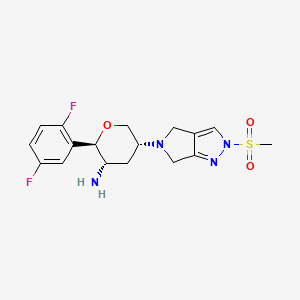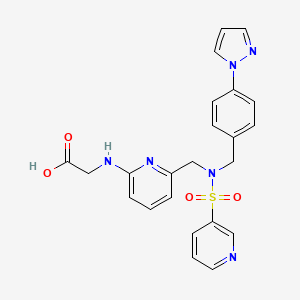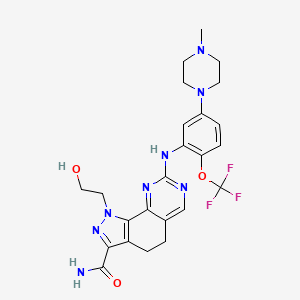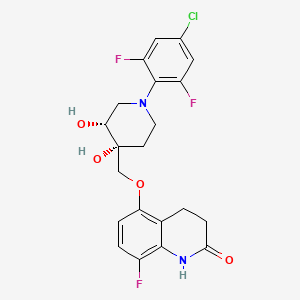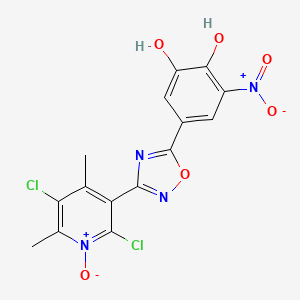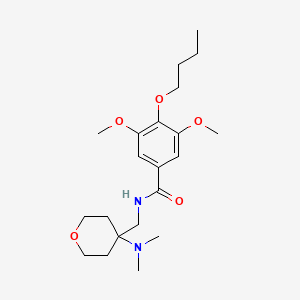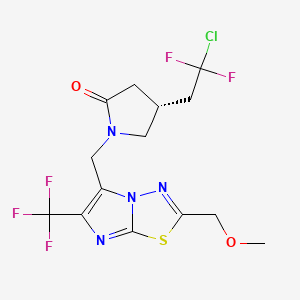
Padsevonil
Vue d'ensemble
Description
Padsevonil est un nouveau candidat médicament antiépileptique développé pour répondre aux besoins non satisfaits des patients atteints d'épilepsie résistante au traitement. Il s'agit d'un composé de première intention qui interagit avec deux cibles thérapeutiques : la protéine 2 des vésicules synaptiques et les récepteurs de l'acide gamma-aminobutyrique A . Ce double mécanisme d'action permet à this compound d'exercer des effets présynaptiques et postsynaptiques, ce qui en fait une option prometteuse pour la prise en charge de l'épilepsie .
Applications De Recherche Scientifique
Padsevonil has been extensively studied for its potential in treating epilepsy, particularly in patients with drug-resistant focal seizures . Clinical trials have demonstrated its efficacy in reducing seizure frequency and improving patient outcomes . Additionally, this compound’s unique mechanism of action makes it a valuable tool for studying the role of synaptic vesicle proteins and gamma-aminobutyric acid A receptors in epilepsy and other neurological disorders . Its dual-target profile also provides insights into the development of new therapeutic strategies for managing epilepsy .
Mécanisme D'action
Target of Action
Padsevonil is a novel antiepileptic drug (AED) candidate that interacts with two therapeutic targets: synaptic vesicle protein 2 (SV2) proteins and GABA A receptors . It has a high affinity for all isoforms of SV2 (SV2A, SV2B, and SV2C) and a low-to-moderate affinity for the benzodiazepine binding site on GABA A receptors .
Mode of Action
This compound’s interaction with SV2A differs from that of levetiracetam and brivaracetam; it exhibits slower binding kinetics . At recombinant GABA A receptors, this compound displayed low to moderate affinity for the benzodiazepine site . In electrophysiological studies, its relative efficacy compared with zolpidem (a full-agonist reference drug) was 40%, indicating partial agonist properties .
Biochemical Pathways
This compound acts as a positive allosteric modulator of GABA A receptors, with a partial agonist profile at the benzodiazepine site . This interaction enhances the inhibitory effects of GABA, increasing the influx of chloride ions into the neuron and thereby hyperpolarizing the neuron. This makes it more difficult for the neuron to reach the threshold potential necessary to initiate an action potential, thus reducing neuronal excitability .
Pharmacokinetics
In a study conducted on healthy Chinese subjects, the concentration-time profile of this compound showed rapid absorption with a median tmax of 1.25 h, followed by an apparent biphasic disposition . For this compound, the geometric means of AUC (0-t), AUC, Cmax, and t1/2 were 6,573 hng/mL, 6,588 hng/mL, 1,387 ng/mL, and 5.275 h, respectively .
Result of Action
This compound displayed robust efficacy across several validated seizure and epilepsy models, including those considered to represent drug-resistant epilepsy . In the amygdala kindling model, which is predictive of efficacy against focal to bilateral tonic-clonic seizures, this compound provided significant protection in kindled rodents .
Analyse Biochimique
Biochemical Properties
Padsevonil interacts with two therapeutic targets: synaptic vesicle protein 2 and GABA A receptors . The optimal this compound occupancy associated with non-clinical efficacy was translatable to humans for both molecular targets: high (>90%), sustained synaptic vesicle protein 2A occupancy and 10–15% transient GABA A receptor occupancy .
Cellular Effects
This compound suppresses seizures without inducing cell death in neonatal rats . It displayed dose-dependent anti-seizure effects in immature rodents in the pentylenetetrazole (PTZ) model of seizures .
Molecular Mechanism
The molecular mechanism of this compound involves its interaction with synaptic vesicle protein 2 and GABA A receptors . This dual interaction allows this compound to exert its effects at the molecular level, including binding interactions with these biomolecules .
Temporal Effects in Laboratory Settings
In a Phase IIa proof-of-concept trial, patients with highly treatment-resistant epilepsy were given this compound as an add-on to their stable regimen . The effects of this compound were observed over a period of 3 weeks in an inpatient double-blind period, followed by an 8-week outpatient open-label period .
Dosage Effects in Animal Models
In animal models, this compound showed dose-dependent anti-seizure effects . At higher doses, it was particularly effective at suppressing tonic-clonic seizure manifestations .
Méthodes De Préparation
Padsevonil a été synthétisé par le biais d'un programme de chimie médicinale visant à concevoir des composés ayant une forte affinité pour les protéines 2 des vésicules synaptiques et une affinité faible à modérée pour le site de liaison des benzodiazépines sur les récepteurs de l'acide gamma-aminobutyrique A . Les voies de synthèse spécifiques et les conditions réactionnelles pour this compound n'ont pas été divulguées dans la littérature disponible. On sait que le composé a été développé par une conception rationnelle et une optimisation de son profil pharmacologique .
Analyse Des Réactions Chimiques
Padsevonil subit diverses réactions chimiques, notamment la liaison aux protéines 2 des vésicules synaptiques et aux récepteurs de l'acide gamma-aminobutyrique A . Le composé présente une forte affinité pour les isoformes 2A, 2B et 2C de la protéine 2 des vésicules synaptiques, avec une cinétique de liaison plus lente que d'autres médicaments antiépileptiques tels que la lévétiracétam et la brivaracétam . This compound présente également une affinité faible à modérée pour le site de liaison des benzodiazépines sur les récepteurs de l'acide gamma-aminobutyrique A, indiquant des propriétés d'agoniste partiel . Les principaux produits formés à partir de ces réactions comprennent les complexes liés de this compound avec ses protéines cibles .
Applications de la recherche scientifique
This compound a été largement étudié pour son potentiel dans le traitement de l'épilepsie, en particulier chez les patients atteints de crises focales résistantes aux médicaments . Les essais cliniques ont démontré son efficacité dans la réduction de la fréquence des crises et l'amélioration des résultats pour les patients . De plus, le mécanisme d'action unique de this compound en fait un outil précieux pour étudier le rôle des protéines 2 des vésicules synaptiques et des récepteurs de l'acide gamma-aminobutyrique A dans l'épilepsie et d'autres troubles neurologiques . Son profil à double cible fournit également des informations sur le développement de nouvelles stratégies thérapeutiques pour la prise en charge de l'épilepsie .
Mécanisme d'action
This compound exerce ses effets en se liant à la protéine 2 des vésicules synaptiques et au site des benzodiazépines sur les récepteurs de l'acide gamma-aminobutyrique A . Ce double mécanisme d'action permet à this compound de moduler à la fois l'activité présynaptique et postsynaptique, ce qui entraîne un meilleur contrôle des crises . En ciblant la protéine 2 des vésicules synaptiques, this compound inhibe la libération de neurotransmetteurs, tandis que son interaction avec les récepteurs de l'acide gamma-aminobutyrique A améliore la neurotransmission inhibitrice . Cette combinaison d'actions contribue à son efficacité robuste dans divers modèles de crises et d'épilepsie .
Comparaison Avec Des Composés Similaires
Padsevonil est unique parmi les médicaments antiépileptiques en raison de son profil à double cible, qui lui permet d'interagir à la fois avec la protéine 2 des vésicules synaptiques et les récepteurs de l'acide gamma-aminobutyrique A . Des composés similaires comprennent la lévétiracétam et la brivaracétam, qui sont des ligands sélectifs de la protéine 2A des vésicules synaptiques . La capacité de this compound à se lier aux trois isoformes de la protéine 2 des vésicules synaptiques et ses propriétés d'agoniste partiel au site des benzodiazépines sur les récepteurs de l'acide gamma-aminobutyrique A le distinguent de ces autres médicaments . Ce mécanisme d'action unique confère à this compound des propriétés anticonvulsivantes améliorées par rapport à la combinaison de composés ciblant la protéine 2A des vésicules synaptiques et le site des benzodiazépines .
Propriétés
IUPAC Name |
(4R)-4-(2-chloro-2,2-difluoroethyl)-1-[[2-(methoxymethyl)-6-(trifluoromethyl)imidazo[2,1-b][1,3,4]thiadiazol-5-yl]methyl]pyrrolidin-2-one | |
|---|---|---|
| Source | PubChem | |
| URL | https://pubchem.ncbi.nlm.nih.gov | |
| Description | Data deposited in or computed by PubChem | |
InChI |
InChI=1S/C14H14ClF5N4O2S/c1-26-6-9-22-24-8(11(14(18,19)20)21-12(24)27-9)5-23-4-7(2-10(23)25)3-13(15,16)17/h7H,2-6H2,1H3/t7-/m1/s1 | |
| Source | PubChem | |
| URL | https://pubchem.ncbi.nlm.nih.gov | |
| Description | Data deposited in or computed by PubChem | |
InChI Key |
DCXFIOLWWRXEQH-SSDOTTSWSA-N | |
| Source | PubChem | |
| URL | https://pubchem.ncbi.nlm.nih.gov | |
| Description | Data deposited in or computed by PubChem | |
Canonical SMILES |
COCC1=NN2C(=C(N=C2S1)C(F)(F)F)CN3CC(CC3=O)CC(F)(F)Cl | |
| Source | PubChem | |
| URL | https://pubchem.ncbi.nlm.nih.gov | |
| Description | Data deposited in or computed by PubChem | |
Isomeric SMILES |
COCC1=NN2C(=C(N=C2S1)C(F)(F)F)CN3C[C@H](CC3=O)CC(F)(F)Cl | |
| Source | PubChem | |
| URL | https://pubchem.ncbi.nlm.nih.gov | |
| Description | Data deposited in or computed by PubChem | |
Molecular Formula |
C14H14ClF5N4O2S | |
| Source | PubChem | |
| URL | https://pubchem.ncbi.nlm.nih.gov | |
| Description | Data deposited in or computed by PubChem | |
Molecular Weight |
432.8 g/mol | |
| Source | PubChem | |
| URL | https://pubchem.ncbi.nlm.nih.gov | |
| Description | Data deposited in or computed by PubChem | |
CAS No. |
1294000-61-5 | |
| Record name | Padsevonil [USAN:INN] | |
| Source | ChemIDplus | |
| URL | https://pubchem.ncbi.nlm.nih.gov/substance/?source=chemidplus&sourceid=1294000615 | |
| Description | ChemIDplus is a free, web search system that provides access to the structure and nomenclature authority files used for the identification of chemical substances cited in National Library of Medicine (NLM) databases, including the TOXNET system. | |
| Record name | Padsevonil | |
| Source | DrugBank | |
| URL | https://www.drugbank.ca/drugs/DB14977 | |
| Description | The DrugBank database is a unique bioinformatics and cheminformatics resource that combines detailed drug (i.e. chemical, pharmacological and pharmaceutical) data with comprehensive drug target (i.e. sequence, structure, and pathway) information. | |
| Explanation | Creative Common's Attribution-NonCommercial 4.0 International License (http://creativecommons.org/licenses/by-nc/4.0/legalcode) | |
| Record name | PADSEVONIL | |
| Source | FDA Global Substance Registration System (GSRS) | |
| URL | https://gsrs.ncats.nih.gov/ginas/app/beta/substances/0R1HN52K0N | |
| Description | The FDA Global Substance Registration System (GSRS) enables the efficient and accurate exchange of information on what substances are in regulated products. Instead of relying on names, which vary across regulatory domains, countries, and regions, the GSRS knowledge base makes it possible for substances to be defined by standardized, scientific descriptions. | |
| Explanation | Unless otherwise noted, the contents of the FDA website (www.fda.gov), both text and graphics, are not copyrighted. They are in the public domain and may be republished, reprinted and otherwise used freely by anyone without the need to obtain permission from FDA. Credit to the U.S. Food and Drug Administration as the source is appreciated but not required. | |
Synthesis routes and methods
Procedure details











Avertissement et informations sur les produits de recherche in vitro
Veuillez noter que tous les articles et informations sur les produits présentés sur BenchChem sont destinés uniquement à des fins informatives. Les produits disponibles à l'achat sur BenchChem sont spécifiquement conçus pour des études in vitro, qui sont réalisées en dehors des organismes vivants. Les études in vitro, dérivées du terme latin "in verre", impliquent des expériences réalisées dans des environnements de laboratoire contrôlés à l'aide de cellules ou de tissus. Il est important de noter que ces produits ne sont pas classés comme médicaments et n'ont pas reçu l'approbation de la FDA pour la prévention, le traitement ou la guérison de toute condition médicale, affection ou maladie. Nous devons souligner que toute forme d'introduction corporelle de ces produits chez les humains ou les animaux est strictement interdite par la loi. Il est essentiel de respecter ces directives pour assurer la conformité aux normes légales et éthiques en matière de recherche et d'expérimentation.


